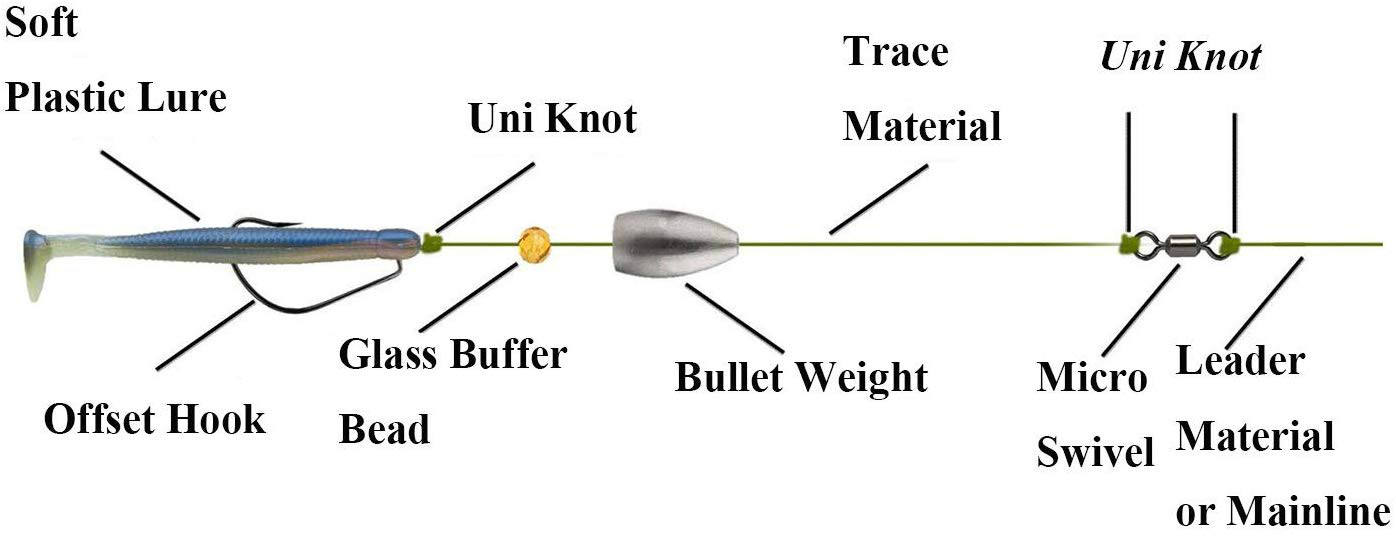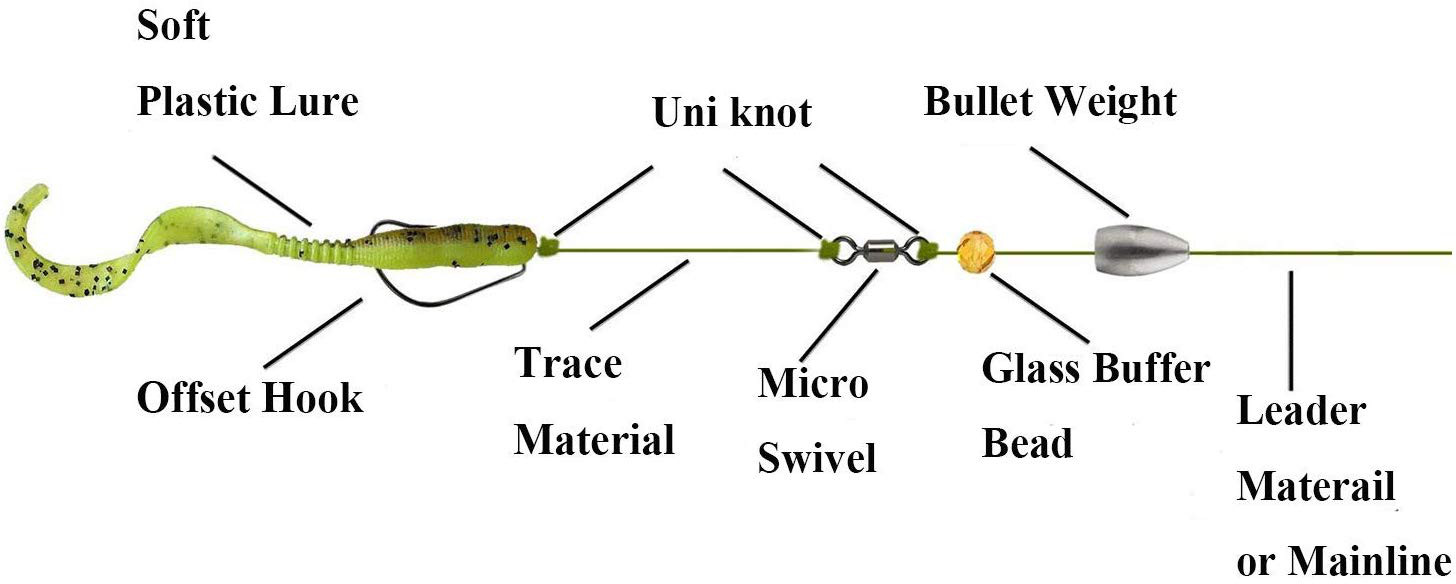When to Use a Texas Rig vs. Carolina Rig
These days, thanks in large part to these tournaments, there's more to fishing than simply wooden canes with strings tied to the ends of them. Today, fishing is about the perfect rod and the most innovative reel. It's about choosing the perfect lure or bait and going out in the perfect weather conditions for the fish you're wanting to catch.
One thing that people sometimes don't consider enough - and they certainly should because it's hugely important - is the type of rig they're using. The two most popular types of rigs for most fishermen are the Texas Rig and the Carolina Rig.
Texas Rig Fishing

This particular rig is one of the most old-school fishing rigs there is. People started using this rig about the same time fishing supply companies began manufacturing the world's first plastic lures. This was sometime in the 50s, meaning this rig has been around for nearly eight decades.
The important thing to remember about this rig is that you'll always use a plastic worm for it. There are no exceptions. Also, the worm needs to be put onto the line in a perfectly straight line. If you put it on at an angle or with a curve in it, it's not a true Texas Rig. It also won't work as well as you'd like, and you won't catch many fish.
How to Tie a Texas Rig
The rig is set up in the following manner. The first thing that goes onto your fishing line is your sinker or your weight. The weight is usually bullet-shaped. Next, if you like, you can put on a plastic or glass bead. This bead is not required, but a lot of fishermen like it because they say it helps catch the eyes of the fish better than the worm alone. This is especially true in dark, muddy water, as any sliver of light reflecting off the bead can draw a fish to it.
Furthermore, the bead will make a clicking sound as it's dragged across rocks and other debris in the water. Some fishermen claim this clicking draws fish to it, while others argue it scares them away. It's up to you to decide for yourself and use or not use the bead as you see fit.
After the bead (or the weight if you choose not to use the bead) is on the line, you'll then slide on the worm. The hook then goes into the worm, with about a fourth of it going inside the worm's top and three-fourths of it still protruding from the worm.
The worm is then slid up toward the hook's eye. As you're doing this, you'll want to twist the hook's wire. At the end of the process, the hook's sharp end will be at the worm's face, and the worm should hang straight down. Again, remember if you have a curve or curl, you've done something wrong, and the rig won't work as well.
The Beginner's Rig: The Carolina

What is a Carolina rig? Well, while the Carolina hasn't been around nearly as long as the Texas, the Carolina is probably used more often because it is so simple to tie and because it works in a variety of weather conditions and for catching various types of different fish. It's also great for beginning fishers.
The reason this particular rig is so versatile is because it can be adjusted in many different ways to accommodate different fishing trips. For instance, unlike the Texas, which requires the fisherman to use a plastic worm, the Carolina can be used with numerous different baits or lures.
Some fishers choose to use live bait, including everything from minnows and shad to leeches or night crawlers. Others prefer to use plastic lures, but even here there is some variety. Plastic grubs or leeches are often used, as are lizards, crawdads and flukes.
The size of the hook you use will depend largely on which bait or lure you choose. If you are using bait that is large, then your hook will, by necessity, also be large. The same goes for smaller, more lightweight bait and lures. In small part, your hook size will also depend on what type of fish you're hoping to catch.
Bullet weights are most often used for this type of rig, although heavier sinkers are sometimes substituted if the fisherman is wanting to fish in deeper waters or heavy currents. Fishing line is not super important, but most fishers tend to use line that is heavy-test. This helps get the lure where it needs to be and is also incredibly hard for fish to see.
How to Tie a Carolina Rig?
If you're wondering how to make a Carolina Rig, it's pretty similar to the making of the Texas set-up. The biggest distinction between the two of them - other than the lack of variety and choices with the Texas - is that with a Carolina set-up, the bullet weight or sinker is fixed securely above the hook. It does not slide down onto it.
Which Rig is Better?
There are, of course, fishers out there who will swear by one rig or the other. Some people will use one of these rigs no matter what type of fish they're hoping to catch, what kind of water they're fishing and what the weather conditions are. We all know people like that, right?
Furthermore, there are certain weather conditions and circumstances where either rig can suitably be used. For instance, both rigs work relatively well in the spring and summer months. However, there are actually some circumstances which call for one rig over the other.
When to Use a Texas Rig?
If you're fishing for bass during their spawning season or immediately after their spawning season has passed, you're going to have much better luck using the Texas set-up rather than the Carolina.
Furthermore, the Texas Rig is also going to work much better in shallow waters. It's lighter and not as prone to sinking down into the depths. This also means it's best for use during the fall months because during the fall, bass tend to stay in the shallower part of the water.
If you're fishing on a cloudy or foggy day, this rig will also work better than its competitor.
When to Use a Carolina Rig?
This rig is best used when fishing for species of fish that like to live in deep waters. It is heavier than the Texas, meaning it will sink lower and reach deeper dwelling fish. Because fish tend to go deeper underwater when it's cold outside, this is also the perfect rig for use in winter months.
The Carolina Rig is also great for bass fishing during their pre-spawning season. It also works well in grassy areas or areas with a large brush build-up. This is because it's heavier and not as likely to get caught on things.
How to Fish a Texas Rig?
When it comes to Texas rig fishing, one of the most important things you can do is correctly set up your rig initially. After that, the exact way you fish with it will depend on the specific type of worm you use as bait. However, the general overview of how to fish using the Texas Rig is as follows:
Locate your fishing spot. If you're fishing from the bank, we recommend fishing from an isolated, quiet area. If you're fishing from a boat, pick a quiet, isolated spot where the water isn't too deep.
Pick your target. Once you've found the spot you want to throw your lure into, cast out about 15 feet beyond that point. Be patient, and let your bait hit the bottom of the shallows. Sometimes, you'll get a bite right away. If that is the case, start reeling it in.
If you haven't gotten a bite within the first minute or so, reel in just a little ways to hit the target area you wanted initially. Again, let the lure sink. Once you get a bite, you'll start reeling it in. The best way to do that is by starting out with the tip of rod facing three o'clock. Raise it slowly until you hit 11 o'clock.
At this point, briefly go still. Then reel up your slack, move back to your original position at three o'clock and continue the process. This kind of slow and steady progress will ensure you don't lose the fish in the mad rush to reel it into your boat.
Continue the three to 11 o'clock routine until you've successfully managed to reel in your fish.
How to Fish a Carolina Rig?
Because a Carolina Rig can be trussed up using so many different types of lures, bait, fishing line and weights or sinkers, there is really no set way to tell you how to fish with it. This is simply because there are so many variations on the rig itself, meaning there are exactly that many variations on how to fish with them.
However, a quick Google search will open up pages and pages of tips and tricks on how to fish with various Carolina rigs using various lures and baits. The info is definitely out there; you just have to look for it.
Conclusion
Since human beings first walked the planet, they have fished. Early humans didn't have houses with stoves and refrigerators or restaurants where they could buy their dinners. Fishing was an integral part of their lives.
In some places in the world today, that's still true. There are some countries that still rely heavily on fishing, not only to feed themselves and their families, but for their economies. It's likely that fishing will always be important in the lives of humans.
However, in many places, including most of America, fishing has been relegated to a pastime; it's something to do with family on the weekends or your buddies after work. It's a way to relax and wind down after a long day. It's a leisure activity.
That doesn't mean that fishermen don't take it seriously, though. Many fishermen put as much effort and hard work into having a successful fishing trip as they do at their jobs. That's why fishing competitions and tournaments are still so popular all over the world.
It doesn't matter if you live in a big city or a small town, chances are there are at least a few fishing tournaments going on somewhere near you. Whether it's a "biggest bass" tournament or a "most trout" tournament, people who fish in them take them very seriously.